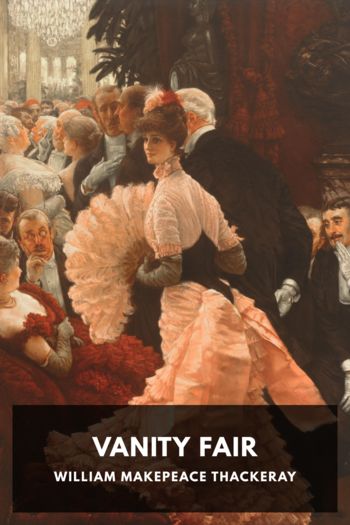Vanity Fair, William Makepeace Thackeray [free ebook reader for iphone TXT] 📗

- Author: William Makepeace Thackeray
Book online «Vanity Fair, William Makepeace Thackeray [free ebook reader for iphone TXT] 📗». Author William Makepeace Thackeray
A few score yards down New Gaunt Street, and leading into Gaunt Mews indeed, is a little modest back door, which you would not remark from that of any of the other stables. But many a little close carriage has stopped at that door, as my informant (little Tom Eaves, who knows everything, and who showed me the place) told me. “The Prince and Perdita have been in and out of that door, sir,” he had often told me; “Marianne Clarke has entered it with the Duke of ⸻. It conducts to the famous petits appartements of Lord Steyne—one, sir, fitted up all in ivory and white satin, another in ebony and black velvet; there is a little banqueting-room taken from Sallust’s house at Pompeii, and painted by Cosway—a little private kitchen, in which every saucepan was silver and all the spits were gold. It was there that Egalité Orleans roasted partridges on the night when he and the Marquis of Steyne won a hundred thousand from a great personage at ombre. Half of the money went to the French Revolution, half to purchase Lord Gaunt’s Marquisate and Garter—and the remainder—” but it forms no part of our scheme to tell what became of the remainder, for every shilling of which, and a great deal more, little Tom Eaves, who knows everybody’s affairs, is ready to account.
Besides his town palace, the Marquis had castles and palaces in various quarters of the three kingdoms, whereof the descriptions may be found in the road-books—Castle Strongbow, with its woods, on the Shannon shore; Gaunt Castle, in Carmarthenshire, where Richard II was taken prisoner—Gauntly Hall in Yorkshire, where I have been informed there were two hundred silver teapots for the breakfasts of the guests of the house, with everything to correspond in splendour; and Stillbrook in Hampshire, which was my lord’s farm, an humble place of residence, of which we all remember the wonderful furniture which was sold at my lord’s demise by a late celebrated auctioneer.
The Marchioness of Steyne was of the renowned and ancient family of the Caerlyons, Marquises of Camelot, who have preserved the old faith ever since the conversion of the venerable Druid, their first ancestor, and whose pedigree goes far beyond the date of the arrival of King Brute in these islands. Pendragon is the title of the eldest son of the house. The sons have been called Arthurs, Uthers, and Caradocs, from immemorial time. Their heads have fallen in many a loyal conspiracy. Elizabeth chopped off the head of the Arthur of her day, who had been Chamberlain to Philip and Mary, and carried letters between the Queen of Scots and her uncles the Guises. A cadet of the house was an officer of the great Duke and distinguished in the famous Saint Bartholomew conspiracy. During the whole of Mary’s confinement, the house of Camelot conspired in her behalf. It was as much injured by its charges in fitting out an armament against the Spaniards, during the time of the Armada, as by the fines and confiscations levied on it by Elizabeth for harbouring of priests, obstinate recusancy, and popish misdoings. A recreant of James’s time was momentarily perverted from his religion by the arguments of that great theologian, and the fortunes of the family somewhat restored by his timely weakness. But the Earl of Camelot, of the reign of Charles, returned to the old creed of his family, and they continued to fight for it, and ruin themselves for it, as long as there was a Stuart left to head or to instigate a rebellion.
Lady Mary Caerlyon was brought up at a Parisian convent; the Dauphiness Marie Antoinette was her godmother. In the pride of her beauty she had been married—sold, it was said—to Lord Gaunt, then at Paris, who won vast sums from the lady’s brother at some of Philip of Orleans’s banquets. The Earl of Gaunt’s famous duel with the Count de la Marche, of the Grey Musqueteers, was attributed by common report to the pretensions of that officer (who had been a page, and remained a favourite of the Queen) to the hand of the beautiful Lady Mary Caerlyon. She was married to Lord Gaunt while the Count lay ill of his wound, and came to dwell at Gaunt House, and to figure for a short time in the splendid Court of the Prince of Wales. Fox had





Comments (0)